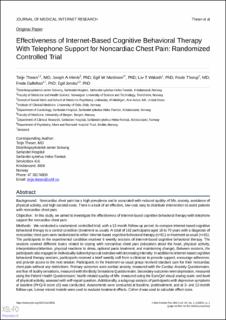| dc.description.abstract | Background: Noncardiac chest pain has a high prevalence and is associated with reduced quality of life, anxiety, avoidance of physical activity, and high societal costs. There is a lack of an effective, low-cost, easy to distribute intervention to assist patients with noncardiac chest pain. Objective:In this study, we aimed to investigate the effectiveness of internet-based cognitive behavioral therapy with telephone support for noncardiac chest pain. Methods: We conducted a randomized controlled trial, with a 12-month follow-up period, to compare internet-based cognitive behavioral therapy to a control condition (treatment as usual). A total of 162 participants aged 18 to 70 years with a diagnosis of noncardiac chest pain were randomized to either internet-based cognitive behavioral therapy (n=81) or treatment as usual (n=81). The participants in the experimental condition received 6 weekly sessions of internet-based cognitive behavioral therapy. The sessions covered different topics related to coping with noncardiac chest pain (education about the heart, physical activity, interpretations/attention, physical reactions to stress, optional panic treatment, and maintaining change). Between sessions, the participants also engaged in individually tailored physical exercises with increasing intensity. In addition to internet-based cognitive behavioral therapy sessions, participants received a brief weekly call from a clinician to provide support, encourage adherence, and provide access to the next session. Participants in the treatment-as-usual group received standard care for their noncardiac chest pain without any restrictions. Primary outcomes were cardiac anxiety, measured with the Cardiac Anxiety Questionnaire, and fear of bodily sensations, measured with the Body Sensations Questionnaire. Secondary outcomes were depression, measured using the Patient Health Questionnaire; health-related quality of life, measured using the EuroQol visual analog scale; and level of physical activity, assessed with self-report question. Additionally, a subgroup analysis of participants with depressive symptoms at baseline (PHQ-9 score ≥5) was conducted. Assessments were conducted at baseline, posttreatment, and at 3- and 12-month follow-ups. Linear mixed models were used to evaluate treatment effects. Cohen d was used to calculate effect sizes. Results: In the main intention-to-treat analysis at the 12-month follow-up time point, participants in the internet-based cognitive behavioral therapy group had significant improvements in cardiac anxiety (–3.4 points, 95% CI –5.7 to –1.1; P=.004, d=0.38) and a nonsignificant improvement in fear of bodily sensations (–2.7 points, 95% CI –5.6 to 0.3; P=.07) compared with the treatment-as-usual group. Health-related quality of life at the 12-month follow-up improved with statistical and clinical significance in the internet-based cognitive behavioral therapy group (8.8 points, 95% CI 2.8 to 14.8; P=.004, d=0.48) compared with the treatment-as-usual group. Physical activity had significantly (P<.001) increased during the 6-week intervention period for the internet-based cognitive behavioral therapy group. Depression significantly improved posttreatment (P=.003) and at the 3-month follow-up (P=.03), but not at the 12-month follow-up (P=.35). Participants with depressive symptoms at baseline seemed to have increased effect of the intervention on cardiac anxiety (d=0.55) and health-related quality of life (d=0.71) at the 12-month follow-up. In the internet-based cognitive behavioral therapy group, 84% of the participants (68/81) completed at least 5 of the 6 sessions. Conclusions: This study provides evidence that internet-based cognitive behavioral therapy with minimal therapist contact and a focus on physical activity is effective in reducing cardiac anxiety and increasing health related quality of life in patients with noncardiac chest pain. | |

